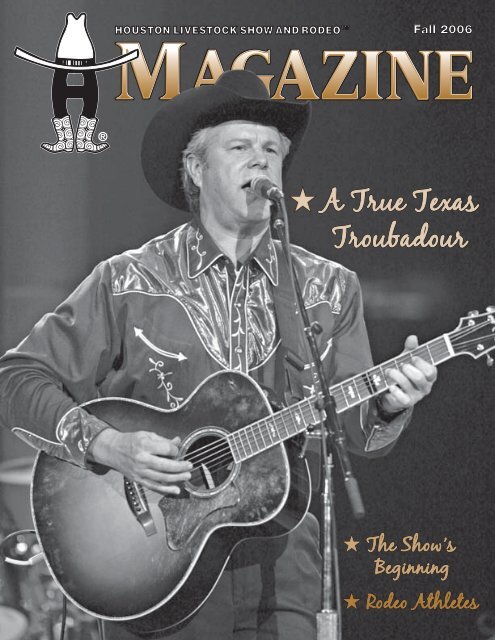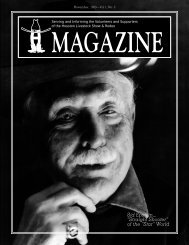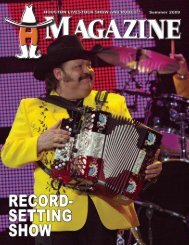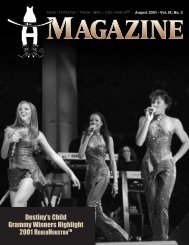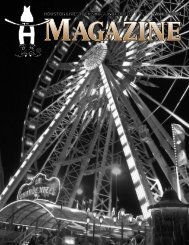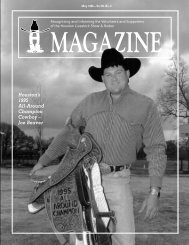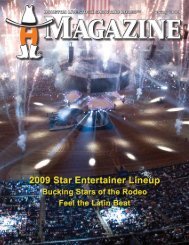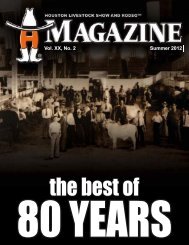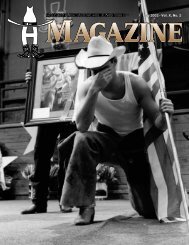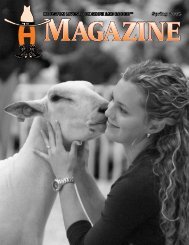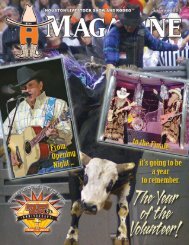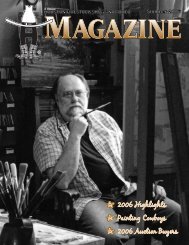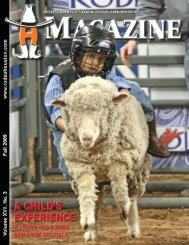HLSR_HmagFallpress CORR.indd - Houston Livestock Show and ...
HLSR_HmagFallpress CORR.indd - Houston Livestock Show and ...
HLSR_HmagFallpress CORR.indd - Houston Livestock Show and ...
- No tags were found...
Create successful ePaper yourself
Turn your PDF publications into a flip-book with our unique Google optimized e-Paper software.
★A True TexasTroubadour★ The <strong>Show</strong>’sBeginning★ Rodeo Athletes
A Message From the Chairman 1FeaturesA Keen Alternative ......................................... 2The Way It All Began ..................................... 4Cotton Pickin’ ............................................... 8The Competitive Advantage .......................... 10Space Scholars .............................................. 12Incoming Vice Presidents .............................. 14Scholarship Student Profiles ......................... 17Committee SpotlightsLamb <strong>and</strong> Goat Auction ................................ 18Ladies’ Go Texan ........................................... 19<strong>Show</strong> News <strong>and</strong> UpdatesThird-Year Committee Chairmen Profiles ..... 20Rodeo Round-Up ........................................... 21Calendar of Events ........................... Back Coverpage 4page 8MAGAZINE COMMITTEEOFFICER IN CHARGEBill R. BludworthCHAIRMANLawrence S LevyVICE CHAIRMENTracy L. RuffenoGina SteereCOPY EDITORKenneth C. Moursund Jr.EDITORIAL BOARDDenise DoyleKatie LyonsMarshall R. Smith IIIConstance WhiteTodd ZuckerPHOTOGRAPHERSDebbie PorterLisa Van EttaREPORTERSBeverly AcockSonya AstonStephanie Earthman BairdTish Zumwalt ClarkGina CovellBr<strong>and</strong>y DivinTeresa EhrmanSusan D. EmfingerSamantha FewoxAlicia M. FilleyBridget HennesseyMelissa KaplanMelissa ManningNan McCrearyKen ScottAmy SloanKristi Van AkenSusan K. WilliamsThe CoverNative <strong>Houston</strong>ian Robert EarlKeen has graced the rotating stageof RODEOHOUSTON five times.Keen brings with him a uniquesound that is true to Texas.page 12<strong>Houston</strong> <strong>Livestock</strong> <strong>Show</strong> <strong>and</strong> Rodeo CHAIRMAN OF THE BOARD:Paul G. SomervillePRESIDENT:Skip WagnerCHIEF OPERATINGOFFICER:Leroy Shafer★A True TexasTroubadour★ The <strong>Show</strong>’sBeginning★ Rodeo AthletesVICE PRESIDENTS:Louis BartBill R. BludworthDanny BoatmanBill BooherCharlene FloydRick GreeneJoe Bruce HancockDarrell N. HartmanDick HudginsCharles W. MeltonJohn A. S<strong>and</strong>lingDavid B. SmithMarshall R. Smith IIIGriffin D. WinnJames A. “Jim” Winne IIIEXECUTIVE COMMITTEE:Joseph T. Ainsworth M.D.Jim BloodworthJohn T. CookTilman J. FertittaDick GravesDon D. JordanStuart LangLouis M. Pearce Jr.Charles R. “Butch” RobinsonJohn O. SmithPaul G. SomervilleKeith A. SteffekR.H. “Steve” StevensP. Michael WellsLIFETIME MEMBERS -EXECUTIVE COMMITTEE:Don A. BuckalewJohn CauseyJ.M. “Jim” ClepperDouglas B. MarshallClayton UnderwoodJames M. Windham Jr.HOUSTON LIVESTOCK SHOWAND RODEOMAGAZINE COORDINATIONMARKETING & PRESENTATIONSDIVISIONMANAGING DIRECTORADVERTISING & PUBLIC RELATIONSJohnnie WesterhausMANAGER - INFORMATION /PUBLICATIONSClint SaundersDESIGN / LAYOUTAmy NoorianSTAFF PHOTOGRAPHERSFrancis M. Martin, D.V. M.Dave ClementsMAGAZINEFall, Volume XIV, No. 3, is published bythe <strong>Houston</strong> <strong>Livestock</strong> <strong>Show</strong> <strong>and</strong> Rodeo.Copyright 2006Letters <strong>and</strong> comments should be sent to:Marketing <strong>and</strong> Presentations Division<strong>Houston</strong> <strong>Livestock</strong> <strong>Show</strong> <strong>and</strong> RodeoP. O. Box 20070,<strong>Houston</strong>, Texas 77225-0070832.667.1000www.rodeohouston.comwww.hlsr.comAgriculture ★ Education ★ Entertainment ★ Western Heritage
A Message From theI want to thank the many recipients of“Bowlegged H” Magazine that, after readingmy article in the last edition, took the time toeither call me or e-mail me with their verypositive remarks. Encouragement <strong>and</strong> praiseare rewarding <strong>and</strong> challenging to produce goodresults, <strong>and</strong> often better than monetary rewards.The very favorable comments reflect our mutualcommitment to values, morals, ethics <strong>and</strong> a wayof life that makes our organization so successful.The officer assignments <strong>and</strong> committeechairmen have all been named <strong>and</strong> thecommittees are all hard at work preparing forthe 2007 <strong>Houston</strong> <strong>Livestock</strong> <strong>Show</strong> <strong>and</strong> Rodeo.The energy <strong>and</strong> excitement are unparalleledas we prepare for one of the largest charitableevents staged anywhere in the world byvolunteers. If you just stop <strong>and</strong> think about it,<strong>and</strong> you had never heard of our organizationor attended one of our <strong>Show</strong>s, you could beoverwhelmed, <strong>and</strong> say, “Where do we start?” Weare going to prepare for more than 1.8 millionpeople to share our facilities with us for 20 days.They are going to be moved in <strong>and</strong> out of ReliantPark in a safe <strong>and</strong> efficient manner, <strong>and</strong> theyare going to be fed, entertained <strong>and</strong> educatedwhile they are with us for a very reasonablecost. The experience will be one that familieswill brag about <strong>and</strong> enjoy for many years tocome. Unmatched prices will be paid to juniorexhibitors for their entries <strong>and</strong> they will bechallenged to work hard in preparing to qualifyfor our events. As a result of all of this, manymillions of dollars will be raised to support theeducation of Texas youth. All of society benefitsfrom the volunteer efforts.This is an especially exciting year as wecelebrate our 75th anniversary <strong>and</strong> “The Yearof the Volunteer.” While we know that it isimpossible to be able to adequately recognizehow important each <strong>and</strong> every person is thatmakes our event such a success, we are going tospotlight for the world that we are a volunteerorganization <strong>and</strong> how important that is to oursuccess. There has been a committee establishedto both celebrate our anniversary <strong>and</strong> honor ourmembers with special events <strong>and</strong> competitions.The committee is hard at work, <strong>and</strong> you will bereceiving more specific information through mailouts, e-mails <strong>and</strong> at your committee meetings.There will be many new events that will be a lotof fun <strong>and</strong> draw a lot of attention.As we are beginning our meetings <strong>and</strong> catchingup on tales with people that we have workedwith for many years, <strong>and</strong> giving the rookies arough time, there has been much work goingon that we often do not know about <strong>and</strong> areunaware of. The staff has many challenges thatthe committee members do not have to deal within preparing for <strong>and</strong> putting on the <strong>Show</strong>. Often,this starts with just getting into their offices <strong>and</strong>navigating around Reliant Center. Each day,they have to find the best gate to get in as theywork around OTC, road race courses, concerts,festivals, trade shows <strong>and</strong> many other set-ups<strong>and</strong> tear-downs that attract large crowds to afacility that maximizes its use. The AccountingDepartment is still collecting money from lastyear, paying bills, dealing with auditors <strong>and</strong>preparing budgets for next year’s <strong>Show</strong>, alongwith many other responsibilities. The IS Divisionis still putting out fires from items that did notgo exactly as someone wanted last year. (I havefound that working with computers can bemore frustrating than working with animals).They are also busy preparing programs tomeet our needs that make the <strong>Show</strong> run asefficiently as possible while being compliant inevery aspect. The Marketing <strong>and</strong> PresentationsDivision was actually working on our next<strong>Show</strong> before we completed the last one. This isa major job dealing with many personalities<strong>and</strong> representatives, <strong>and</strong> on a schedule that isoften not their own. Staff members have torndown many of the temporary facilities such aspens, ticket booths, etc., <strong>and</strong> prepared themfor storage after inspecting them to evaluatefuture use. They will be soon preparing to pullthis equipment back out <strong>and</strong> set them backup. There are many meetings going on all overthe country to ensure the best entertainment<strong>and</strong> the best cowboys come to our <strong>Show</strong>. Weneed the best stock for the Rodeo. We have tomeet with many city <strong>and</strong> county officials toensure compliance with all regulations <strong>and</strong>provide a safe experience for everyone at our<strong>Show</strong>. Many contracts are h<strong>and</strong>led by the <strong>Show</strong>for everything, from sponsors, entertainers,transportation providers, etc. This list justincludes the obvious, <strong>and</strong> there are manyunexpected duties that arise every day. All ofthis <strong>and</strong> helping to coordinate the efforts of17,000 very ambitious <strong>and</strong> motivated volunteers— no wonder you can see the lights burninglate almost every night from now through the2007 <strong>Show</strong>. While we celebrate this year, pleaseremember how important our staff members areto our success, <strong>and</strong> think about all of the workthey are doing that we do not ever hear aboutin our efforts. We are blessed to have a team ofstaff <strong>and</strong> volunteers with the same mission thatwork together so well.I look forward to a great year <strong>and</strong> seeing all ofyou at a meeting real soon.We truly are a very large family. As with anygroup of our size, there are many exciting eventsin individual lives <strong>and</strong> many tragedies. Themembers of our organization rally around anyindividual they need to help in any way thatthey can, <strong>and</strong> their sincerity <strong>and</strong> generosity isas unique as our organization. In my personalsituation, I have been overwhelmed by the love<strong>and</strong> prayers that I see for my family, as wellas others in their time of trouble. I urge you tocontinue this fellowship, <strong>and</strong> I know that Godwill reward our faithfulness.God bless each of you!Paul Somerville1
Keen AlternativeA KeenBy Kristi Van AkenSome folks call his music “alternative country,”some call it “Texas country,” <strong>and</strong> others refer toit as “not mainstream.” Singer/songwriter RobertEarl Keen calls himself “just a singing cowboy.”On March 6, 2006, native <strong>Houston</strong>ian Keen returned hometo sing his own br<strong>and</strong> of country music to 45,774 fans atRODEOHOUSTON. “I feel very fortunate. My hat is off topeople at the Rodeo who have the courage to book what isconsidered by some as ‘regional’ <strong>and</strong> some as ‘alternative’country music,” said Keen.While live performances are hardly new to Keen, he saidplaying at the <strong>Show</strong> falls into the category of “my wildestdreams,” <strong>and</strong> he confessed he always gets a lump in his throatwhen singing to his hometown crowd. “Playing the Rodeo isthe best thing I could ever imagine.”2In some ways, Keen’s imagination helps him play to the <strong>Show</strong>fans, who are seated far from the stage in Reliant Stadium.“The audience is that big,” Keen said, invoking an imageof him holding his thumb <strong>and</strong> forefinger close together toillustrate how small the audience looks from the stage, “<strong>and</strong>you just pretend they’re right there, in your face. We try tospeak a little more slowly <strong>and</strong> play songs that won’t bleed outwith all that echo.”Keen <strong>and</strong> his b<strong>and</strong> played to their audience at the <strong>Show</strong>. Afteropening act Cross Canadian Ragweed performed, Keen <strong>and</strong>his b<strong>and</strong> took the stage with an instrumental cover of “ComeTogether” by The Beatles. Hits “Comin’ Home to You” <strong>and</strong>“Corpus Christi Bay” soon followed. The song for which Keensaid he is probably most famous, “Merry Christmas From theFamily,” was a crowd singalong favorite, as was the title trackfrom his 1994 album “Gringo Honeymoon.” Keen also sangthe ballad “Feelin’ Good Again,” a song he thoroughly enjoys.“It’s a vignette; a homecoming. It’s all true, <strong>and</strong> it seems toresonate with people.”In addition to his five RODEOHOUSTON appearances as anentertainer, Keen has other fond <strong>Houston</strong> <strong>Livestock</strong> <strong>Show</strong><strong>and</strong> Rodeo memories. Once, when he <strong>and</strong> childhoodfriend Bryan Duckworth (who later played in Keen’s b<strong>and</strong> forseven years) were only 14 years old, they sneaked onto theAstrodome floor to catch a glimpse of a real cowboy. “Ourbiggest aspiration was to be rodeo cowboys,” said Keen.“During the Gr<strong>and</strong> Entry, we slipped along the rail <strong>and</strong> downthe ramp near the door. We stayed in the shadows. We sawthis guy with a riggin’ bag that said ‘Rusty Riddle’ <strong>and</strong>, fora second, we forgot where we were <strong>and</strong> we screamed hisname — ‘Rusty!’ We were busted. The other cowboys saw us,opened the door, <strong>and</strong> let us in. We watched the entire Rodeost<strong>and</strong>ing on the chutes. It was great.”Seeing the livestock projects is just as exciting to Keen aswatching the bull riding. Before his 2006 performance, Keentook time to tour Reliant Center to talk with the exhibitors.He admires <strong>and</strong> respects the mission of the <strong>Houston</strong> <strong>Livestock</strong><strong>Show</strong> <strong>and</strong> Rodeo. “It’s really a wonderful focus. It teachesparents <strong>and</strong> children to work together on a project all yearlong. It brings families <strong>and</strong> communities together,” he said.“It’s awe-inspiring. <strong>Houston</strong> represents the largest rodeo,including livestock — really exotic show cattle like Simmental— from Europe, Asia <strong>and</strong> the British Isles. I have admiration
for anyone who works with animals. Really, the reward is apersonal one.”Keen puts his money where his mouth is when it comesto supporting youth, agriculture <strong>and</strong> education. At a smalllivestock show in Medina, Texas, he bid on different auctionsfor “kids who possibly needed a little help with the bidding.”Keen revealed that he bought a few rabbits that day.Keen is astutely aware that caring for <strong>and</strong> raising animalsrequires dedication, talent <strong>and</strong> a little luck. “We had somecows for a while. I really loved it. It was very calming for meto feed the cows <strong>and</strong> then just watch them. They’re very Zenlike.They just sit there <strong>and</strong> eat. There’s nothing else but beinga cow for them,” he observed.There’s nothing else but being a performer for Keen. He <strong>and</strong>his b<strong>and</strong> tour constantly, playing the 70,000-seat ReliantStadium one week <strong>and</strong> a honky-tonk with a st<strong>and</strong>ing-roomonlycapacity of 600 the next. “We’re a touring b<strong>and</strong>. We tourall year-round. One month we’re in Vegas; next month, we’reat a feed store. We play where we play — some huge festivals,some bars. We are live entertainment that people come tosee,” he said.When people cannot come to Keen, Keen comes to thepeople. International Space Station Comm<strong>and</strong>er BillMacArthur recently shared — from space — with a groupof students that Keen is one of his favorite singers. Shortlythereafter, Keen visited the Johnson Space Center in <strong>Houston</strong><strong>and</strong> made a surprise call to the International Space Station.He sang “Mr. Wolf <strong>and</strong> Mama Bear” <strong>and</strong> “Feelin’ Good Again”to MacArthur.“Bill was so happy about the videoconference with RobertEarl. I mean super happy. He was absolutely thrilled. He saidthat he was totally caught by surprise,” commented Dr. SeanRoden, NASA flight surgeon.Texans never have seemed too concerned about following thecrowd, <strong>and</strong> Robert Earl Keen’s Texas-bred independence is arefreshing alternative to the mainstream. From the extremelylong-distance call to a fan to his own minor acting roles in afew B-movies or singing about Christmases with the family,Keen enjoys being slightly beyond the mainstream. “I have areally good job,” he said. Who can argue with that!3
Now 88 <strong>and</strong> still an active rancher, she attended that first<strong>Show</strong> with her father, <strong>and</strong> her memories are vivid. Marksrecalled that her father held rodeos at their ranch west of<strong>Houston</strong> near Barker, Texas, for years. Even though the<strong>Show</strong> had no real rodeo <strong>and</strong> no arena at that time, her fatherbrought his saddle broncs <strong>and</strong> other animals. “He paid areacowboys ‘mount money’ to ride bucking broncs in an openarea on the floor,” Marks said. “We were just trying to dosomething to help the <strong>Show</strong> come alive.”It has been reported that a formal parade was first a part ofthe <strong>Show</strong> in 1938, but Marks remembers it differently. “Idon’t care what anybody says, there was a parade in 1932.I know, I was in it,” she said. She was about 13 years old.“Someone said, ‘Maudeen can ride’ <strong>and</strong> put me up on thispony <strong>and</strong> said, ‘Go!’ Anybody there with a horse or anythingthat could be in the parade, got in,” she recalled. “But, it wasa pretty skinny parade.”There were more than top show cattle <strong>and</strong> thoroughbredsat the <strong>Houston</strong> Fat Stock <strong>Show</strong>. To entice visitors, <strong>Show</strong>officials provided free barbecue on the first Saturday. TheApril 30, 1932, <strong>Houston</strong> Chronicle reported, “[T]here hasbeen prepared a varied vaudeville program for the evenings.These programs will draw some of <strong>Houston</strong>’s best dancing<strong>and</strong> singing talent during the week.”The <strong>Show</strong> continued to grow through 1936, but, in 1937,Sam <strong>Houston</strong> Hall was razed. The next 18 months werespent on a statewide goodwill tour to increase support forthe <strong>Show</strong> <strong>and</strong> its purpose. Although there was no budget toinclude a rodeo as part of the event, a small group of areamen took on the task <strong>and</strong> financed one.In October 1938, the new 74,000-square-foot, 10,000-seatcapacity Sam <strong>Houston</strong> Coliseum was ready to offer whatSartwelle proclaimed to be “The <strong>Show</strong> of <strong>Show</strong>s.” That wasthe first year for an official parade, an organized rodeo, ahorse show <strong>and</strong> a floorshow, called the International Review,featuring “The Gay Corral Follies” every night after therodeo. Souvenir programs sold for 15 cents, tickets soldfor $1.10 <strong>and</strong> more than 100,000 attended the successful10-day event. The 1938 <strong>Show</strong> was pivotal, proving it hadbecome <strong>Houston</strong>’s largest <strong>and</strong> most successful civic event.In 1932, the <strong>Show</strong> had an attendance of about 2,000, <strong>and</strong>,although it lost about $2,800, the effort was considereda success because it began the heart of the <strong>Show</strong> —volunteerism. The 2006 <strong>Show</strong> recorded a general attendanceof more than 1.6 million, gave more than $7.8 million indirect educational support <strong>and</strong> happened only with the helpof almost 17,000 volunteers.James D. “Bubba” Sartwelle, a Lifetime Vice President, <strong>and</strong>W.C. “Bill” Sartwelle, a <strong>Show</strong> director <strong>and</strong> Elise’s father, areJ.W.’s gr<strong>and</strong>sons. Bubba <strong>and</strong> Bill, whose father, James D.Sartwelle Sr., served as a <strong>Show</strong> officer, grew up in the <strong>Show</strong><strong>and</strong> still operate Port City Stockyards. “My gr<strong>and</strong>dad <strong>and</strong> themen who worked to get the <strong>Show</strong> going were visionaries,”said Bubba. When asked if his gr<strong>and</strong>father would besurprised at how much the <strong>Show</strong> has grown through theyears, he said, “Oh yes, <strong>and</strong> wouldn’t he be pleased.”7
By Nan McCrearyIt’s a fiber, a seed <strong>and</strong> a food crop. Its lint is used to makeblue jeans, shirts, towels, sheets, blankets, diapers,draperies, medical supplies <strong>and</strong> U.S. currency. Its seed ispressed for oil, which is used as an ingredient in fast foods,salad dressings <strong>and</strong> cooking. And, its discarded hulls areused as animal feed. What is this all-purpose commodity? It’scotton, the largest cash crop in Texas.Cotton is defined by the U.S. Department of Agriculture as“a soft white vegetable fiber that grows around the seed ofthe cotton plant.” Cotton is truly a miracle of nature. It hasbeen called “white gold,” “the fabric of our lives” <strong>and</strong> “thefiber with a thous<strong>and</strong> faces.” In Texas,it has earned the title of “King,” as thestate’s annual harvest leads the nation incotton production.Texas farmers produce 7 million to8 million bales of cotton annually,garnering a $1.5 billion share of atotal $5.2 billion economic impact forcotton <strong>and</strong> its byproducts. Across thestate, cotton is grown in six differentregions on more than 5 million acres.Each region is characterized by uniquetypes of climate, soil, rainfall, irrigation<strong>and</strong> harvesting techniques, whichrequire different production systems.Surrounded by more than 60 percentof the state’s cotton crop, Lubbock,Texas, located in the High Plains area, is the self-proclaimed“cottonest city” in the world.From planting to market, cotton’s journey is precarious.During its 150- to 180-day growing season — the longestof any annually planted crop in the country — the crop issusceptible to insects, diseases <strong>and</strong> the whims of nature.Too delicate to survive hail, heavy wind or rain, it cannot betoo hot nor too cold, <strong>and</strong> it cannot receive too much waternor too little. Conditions must be “just right” for a plant toproduce a mature, harvestable cotton boll.Texas boasts two varieties of cotton: the long-fiber pima, orEgyptian type, <strong>and</strong> the short-fiber upl<strong>and</strong>, the most commontype of cotton grown in the United States. Depending onweather conditions, planting in South Texas begins as earlyas February, <strong>and</strong> in the High Plains, as late as June. Highlyspecialized machines — called precision planters — placecotton seedlings in the soil at uniform depths <strong>and</strong> intervals,covering as many as 10 to 24 rows at a time. Within sevento 14 days, the seedlings take root. Four to six weeks later,flower buds form on the plant. In three more weeks, theblossoms open only to wither <strong>and</strong> die after three days. Whatremains are the cotton ovaries, which mature <strong>and</strong> enlarge intopods, called cotton bolls. After 50 to 70 more days, the bollsopen to the air <strong>and</strong> dry to white, fluffy, seed-filled fiber podspoised for harvest.Timing of a cotton harvest is abalancing act in which boll quality <strong>and</strong>yield are at risk. If picked too early,the bolls might be of inferior quality.However, the longer the bolls stay onthe plant, the greater the risk is forthem to be damaged or completelyruined by severe weather.Even the harvesting method affectsthis balance. H<strong>and</strong>picking is slow,laborious <strong>and</strong> costly, but the effectiveyield percentage is high. Twotechniques primarily used to harvestcotton in Texas are “picker” <strong>and</strong>“stripper” harvesting. Complex pickingmachines mechanically twist thecotton fiber <strong>and</strong> seed from the plant, resulting in less waste,yet higher harvest costs. The more commonly used stripperharvesters pull the entire boll from the plant. The cotton fiber,the hulls <strong>and</strong> the cottonseed are separated later.Once harvested, the cotton is formed into modules, whichare protected from moisture <strong>and</strong> stored until they can bedelivered to the cotton gin. At the gin, the cottonseed, whichmakes up about two-thirds of the harvested crop, is separatedmechanically from the cotton fiber or lint. This ginned fiber ispressed together into bales, each weighing about 500 pounds.The seed is crushed to extract the oil, which is used primarilyfor food products. The residual seed meal <strong>and</strong> hulls are used,either separately or in combination, as livestock feeds <strong>and</strong>fertilizer.8
After the cotton has been baled, the market price is at itslowest due to increased supply. Growers might sell theircotton lint to recover costs or decide to store their crop <strong>and</strong>wait for prices to rise. Texas is the nation’s top cotton exporter.Typically, half of Texas cotton goes to mills in Mexico <strong>and</strong>other foreign markets, where it competes with cotton fromBrazil, Africa, Turkey <strong>and</strong> Central Asian countries.The greatest challenge Texas cotton growers face — inaddition to the weather, diseases <strong>and</strong> insects — is the value ofthe dollar. In a global economy, profits depend on monetaryexchange rates, foreign cotton production, internationalimport <strong>and</strong> export policies, surplus or stored stocks, <strong>and</strong>worldwide supply <strong>and</strong> dem<strong>and</strong> for cotton. Cotton priceshave been relatively stable for the past quarter century, withNew York cotton futures trading from 50 cents to 70 centsa pound. In 1800, prior to the invention of the cotton gin,cotton sold for 37 cents per pound, an equivalent of about$2.89 per pound in today’s dollars.The 21st century cotton farmer must be a savvy entrepreneurto succeed in a global market <strong>and</strong> must be willing to acceptthe challenges of weed control, insect management, soilconservation, irrigation <strong>and</strong> even Mother Nature. Spanishmissionaries first farmed cotton near present-day San Antonioin 1745 <strong>and</strong> produced just a few thous<strong>and</strong> pounds of cottonannually. Today’s farmer can produce about 500,000 poundsof cotton lint a year from 1,000 acres — enough cotton forabout 1.3 million T-shirts.THINGS THAT CAN BE MADEFROM ONE BALE OF COTTON:215 Pairs of Jeans249 Bed Sheets409 Men’s Sport Shirts690 Terry Bath Towels765 Men’s Dress Shirts1,217 Men’s T-Shirts1,256 Pillowcases2,104 Boxer Shorts2,419 Men’s Briefs3,085 Diapers4,321 Mid-Calf Socks6,436 Women’s Briefs21,960 Women’s H<strong>and</strong>kerchiefs313,600 $100 BillsSource: National Cotton Council of AmericaCotton has been king in Texas since before the Civil War.With a world dem<strong>and</strong> for tight-fitting jeans, comfy T-shirts,luxuriously soft bedding <strong>and</strong> absorbent towels,Texas farmers will continue to findhigh-tech <strong>and</strong> efficient ways tomaximize crop yields.Long live King Cotton.Photos courtesy of theNational Cotton Council of America9
The CompetitiveBy Katie LyonsWhat does it take to become a rough <strong>and</strong> toughcowboy? Power lifting? Cardiovascular training?A professional cowboy, like any other competitiveathlete, must build endurance <strong>and</strong> train intensely to remainactive at an elite level. His physical stamina is put to the testwith each rodeo competition.At each performance, RODEOHOUSTON spectators sit on theedge of their seats, watching the action-packed rodeo events.For a cowboy awaiting his opportunity to shine on a buckingbull or bronc, it takes just a few seconds to achieve success. Acowboy spends hours each week practicing on a bucking bullor bronc, but consider what a cowboy has to do to better hisown body to keep up with the high level of competition, or,more importantly, to prevent injury.“Rodeo is one of the most dangerous sportsin the world,” said Dale Kiecke, a physicaltherapist, certified athletic trainer <strong>and</strong>program manager with the Justin Boots’Sportsmedicine Team in the SouthwestRegion. “More injuries occur in rodeothan any other sport.These guys have to betough to ride throughinjury. They liftweights <strong>and</strong> train constantly to preparefor their event.”No athlete’s training program will be exactly like another’s.Some athletes focus on building muscle mass; others focus onspeed <strong>and</strong> agility; still others must increase their cardiovascularendurance. How exactly does a typical rodeo cowboy preparehis body to be competitive?Tie-down roper Fred Whitfield, the 2000 RODEOHOUSTONcalf roping champion, was inducted into the ProRodeo Hallof Fame in 2004. This eight-time world champion cowboysaid, “Rodeo is a whole different ballgame now with the kidscoming up in the rodeo who have been athletes all their lives,whether it was football, basketball, etc. It is now more aboutspeed than talent.”Zach Dishman, a 23-year-old bareback bronc ridingcontestant, takes his physical conditioning seriously. Hefrequently spends time exercising — not to grow muscle massbut to prevent injury. “When I exercise, I think about winning<strong>and</strong> bettering myself,” said Dishman. He credits his stretching<strong>and</strong> his focus on conditioning with allowing him to recovermore quickly from injuries. Early in his career, Dishmansuffered a rotator cuff injury that taught him the value ofexercise <strong>and</strong> conditioning.According to Kiecke, an injury to the shoulder or rotator cuffarea is probably the fourth most frequently seen. “The majorityof rodeo-related injuries occur along the spine — from thehead to the lumbar area,” said Kiecke. “Some injuries youcannot prevent, such as fractures or trauma from coming incontact with the animal. Without properly stretching <strong>and</strong>conditioning themselves, cowboys would be even morevulnerable to injury.”The Justin Sportsmedicine Team spends time educatingcowboys on the proper stretching techniques needed toprevent injury as well as how to rehabilitate themselves afteran injury. “Most of these cowboys live on a ranch or in a smalltown; we give them a home rehabilitation program to followon their own,” said Kiecke.The athlete must be committed, not only to increasing physicalstrength, but also to increasing mental strength. It takes focus,determination <strong>and</strong> a strong initiative to push oneself to thenext level. Whitfield believes that working out helps him tomentally <strong>and</strong> physically believe that he can win. “It gives methe mental frame of mind to find success,” he said.10
Advantage“There is no such thing as ‘injured reserve’ in rodeo. If you can’t ride <strong>and</strong>compete, you don’t get paid,” said Kiecke. “Most contestants are toughenough to ride with some form of minor injury. Sometimes it’s all wecan do to keep them from riding with a significant injury.” Mentally, thecowboy has to be prepared for anything that might happen during anevent.Bryan Hammons, saddle bronc riding contestant, strongly agrees withWhitfield. “I believe that rodeo is more of a mental game than a physicalgame,” Hammons said. He served in the U.S. Marine Corps beforestarting on the rodeo circuit. He attributes his ability to run <strong>and</strong> to keepup his cardiovascular condition to his time <strong>and</strong> intense training in theMarine Corps, both physical <strong>and</strong> mental.Cody Buller, a 25-year-old bull rider, credits his focus on conditioningto training in high school <strong>and</strong> to not allowing laziness to get the bestof him. “When I was in high school, I wrestled competitively, playedfootball <strong>and</strong> lifted weights every day to stay in shape for rodeo,” saidBuller. His strict schedule early in life helped to prepare himmentally for the dedication needed for professional rodeo.He also acknowledged the benefits of staying fit whichhelped him set the pace that has led to his success today.When Buller is home, he frequents the gym — he evenrides a unicycle to practice balance <strong>and</strong> concentration.Few people would argue with the notion that cowboys arerugged individuals, but even the toughest might get injuredin the competitive field. Most cowboys agree that, if theyhad more time in their schedules, they would focus moreon their personal strength <strong>and</strong> physical condition. Not onlyis it difficult to find the time to exercise between traveling<strong>and</strong> practicing, it is also expensive to use gyms in differentcities.“At every rodeo, you will see cowboys stretching before theyride. We [Justin Sportsmedicine] will stretch them beforethey ride,” said Kiecke. “As with any sport, stretching helpsto prevent injury.” Kiecke has worked with his share ofinjured cowboys during the 26 years he has been involvedwith the sports medicine group.Rodeo athletes often have been referred to as a breed oftheir own. However, like any other athlete, the cowboys’ultimate success depends on their passion for the sport,their determination, <strong>and</strong> most importantly, their mental <strong>and</strong>physical preparation for each ride.11
SPACECHOLARS12By Stephanie Earthman BairdHAS participants must design <strong>and</strong> build a rover capable ofrunning on a simulated Mars surface.Photos courtesy of Aerospace Scholars ProgramHow can students be guided toward anexciting career in space exploration? Letthem live it for a year! Since 1999, morethan 1,000 students have done just that in thecompany of NASA astronauts <strong>and</strong> scientiststhrough NASA ’ s High School Aerospace Scholarsprogram, underwritten in part by the <strong>Houston</strong><strong>Livestock</strong> <strong>Show</strong> <strong>and</strong> Rodeo Educational Fund.Each November, Texas legislators nominatehigh-school juniors from their districts toparticipate in this prestigious program. The firstphase of HAS begins as a six-month interactive,online learning experience. Next comesthe highlight of the adventure — a six-dayworkshop at the National Aeronautics <strong>and</strong> SpaceAdministration’s Johnson Space Center, wherestudents act as mission scientists.Striving to influence a child’s potential forsuccess in school <strong>and</strong> in life, the <strong>Show</strong> supportsmany educational programs in addition to itswell-known scholarship program. In 2000, the<strong>Show</strong> launched support for HAS. “Our goal toeducate the youth of Texas, coupled with ourclose relationship with NASA, makes it a naturalpartnership,” said <strong>Houston</strong> <strong>Livestock</strong> <strong>Show</strong> <strong>and</strong>Rodeo Chairman of the Board Paul Somerville.“We are blessed to have NASA as partners <strong>and</strong>neighbors, <strong>and</strong> we enjoy working with them tocapture the attention of students in math <strong>and</strong>science studies.”Capture their attention it does! More than 500applications are received each fall. For thefollowing six months, the student applicantsengage in distance learning assignments to learnthe basics of space exploration <strong>and</strong> NASAmissions. De-orbit Burn, Robo-nautics <strong>and</strong>Space Station Science are just three of 10biweekly learning modules that must becompleted successfully in order to qualify for thesummer experience at JSC. Moon/Mars <strong>and</strong>Shuttle/Station online chats make use of thestudents’ e-mail access to NASA experts. InApril, NASA notifies 240 lucky students of theiropportunity to taste life as a NASA engineer.NASA ignites student interest in engineering <strong>and</strong>science professions through HAS. “By harnessingthe excitement of human space exploration,we increase their awareness of the jobopportunities,” explained HAS Program DirectorCharla Stuart. “The funding we receive from the<strong>Houston</strong> <strong>Livestock</strong> <strong>Show</strong> plays a key role inmeeting this education goal,” she added.
The students’ intenseremote studies pay offduring the summerworkshop. Qualifyingstudents participatein an all-expense-paidresidential stay at JSC.Personal briefings byengineers, scientists<strong>and</strong> astronauts; behindthe-scenetours of theSpace Center; <strong>and</strong>h<strong>and</strong>s-on engineeringopportunities are just afew of the activities inwhich students engage.Students learn firsth<strong>and</strong> just how critical teamwork is toNASA ’ s missions. Astronauts charge four teams — GettingThere, Living There, Working There <strong>and</strong> Mission Integration— with designing a feasible manned mission to Mars. Eachteam completes its own detailed design. The weeklonginternship ends with a luncheon, during which studentspresent their project results to NASA engineers, astronauts,state legislators, parents <strong>and</strong> other VIPs, including <strong>Show</strong>officials.NASA not only reviews past missions <strong>and</strong> successes butalso communicates openly with students about current <strong>and</strong>future exploration activities. The 2006 program will shareNASA ’ s vision for returning to the moon, traveling to Mars<strong>and</strong> beyond, <strong>and</strong> completing the planned Crew ExplorationVehicle — America’s first new human spacecraft in 30 years.The CEV will be an integral component in future U.S. spaceexploration architecture.Participating students make a serious commitment. Once thedistance learning modules are completed <strong>and</strong> the summerworkshop has ended, the responsibility continues. Scholarsare asked to maintain an e-mail relationship with their teammentor, stay in touch with fellow scholars <strong>and</strong> help recruitnew students. “It allows students to look at science <strong>and</strong> spacetravel in great detail <strong>and</strong> hopefully engages them in that arenafor the rest of their lives,” said state Rep. John Davis, whosupported initial funding for HAS in the Texas appropriationsbudget in 1999.In addition to the <strong>Show</strong>’s Educational Fund supportingstudent involvement, teachers from across the state also learnabout the U.S. space program by serving as counselors duringthe JSC workshop. Grant Mury was attracted to the programbecause of his love of space. This physics teacher for Alief(Texas) Independent School District’s Elsik High School said,“I always wanted to bea member of a spacecamp. So, you couldsay that I was tryingto live vicariously. Mystudents love to hearthe personal storiesI come back with,although I alwaysleave out the reallycool stuff because itis better for them toexperience it withoutprior knowledge.”After serving three years as a counselor, he has manymemories of his involvement. Mury said that one favorite isseeing the looks on the students’ faces when they meet anastronaut or when they go on the behind-the-scene tours intothe restricted areas.Stuart said, “The student testimonials are the best way toknow that we are meeting our goals. The increased numberof students interested in science, technology, engineering <strong>and</strong>mathematics careers as a result of participating in HAS alsopoints to the program’s success.”The number of former program participants now workingat NASA is further evidence of the program’s success. CherylMorrill, a Texas A&M University student <strong>and</strong> <strong>Houston</strong><strong>Livestock</strong> <strong>Show</strong> <strong>and</strong> Rodeo scholarship winner, is one of eightHAS alumni working at NASA. Morrill said she was directedinto the HAS program by her high-school teachers. “I had noidea what engineering was all about. The program opened myeyes to the broad job opportunities available,” said Morrill.Her HAS experience led to her engineering co-op opportunityat NASA.“The students’ presentations at the end of an intense weekhere at NASA are exciting to watch,” said Robert Cabana,deputy director of Johnson Space Center. “The energy theyhave about space exploration really comes through, <strong>and</strong> ittells me that that our aerospace scholars program is workingto inspire America’s future explorers.” NASA is embarking ona bold, new journey to take humans back to the moon by theyear 2020, <strong>and</strong> today’s students are the ones who are going tomake it happen.For the 2006 summer program, 285 students have beenselected to participate. For more information regarding theHAS program, visit the Web site at http://aerospacescholars.jsc.nasa.gov/HAS.Students visit historic Mission Control Center, where space missions were directed.13
IncomingVice PresidentsBill BooherBy Lawrence S LevyFor nearly 30 years, Bill Booher has served the <strong>Houston</strong> <strong>Livestock</strong> <strong>Show</strong> <strong>and</strong> Rodeo.“I had some friends active in the <strong>Show</strong>, <strong>and</strong> they encouraged me to get involved,” hesaid, having joined as a life member in 1977. First volunteering on the Corral ClubCommittee, his path at the <strong>Show</strong> crisscrosses the map. He served as a vice chairman onthe World’s Championship Bar-B-Que Committee, the Calf Scramble Committee <strong>and</strong>the Magazine Committee, on which he also served as chairman.When President Skip Wagner told him of his newest <strong>Show</strong> responsibility, “Boo,” as he isknown by many, said, “I was very excited <strong>and</strong> honored that I was given the opportunityto serve the <strong>Show</strong> as a vice president.” Booher will serve as officer in charge of fourcommittees: All Breeds <strong>Livestock</strong> Sales, Breeders Greeters, Junior Commercial SteerFeeding <strong>and</strong> Management Contest, <strong>and</strong> <strong>Livestock</strong>. He said that he believes that the<strong>Show</strong> hierarchy felt this related core group of committees was a good fit for him. Whenasked about his intentions as a first-year officer in charge, he said, “I hope to buildupon the existing foundation of the committees, make sure we accomplish our goals<strong>and</strong> have a fun time doing it.”Booher is employed by Forge USA in sales <strong>and</strong> marketing. His wife, Pam, is a <strong>Show</strong> life member whovolunteers on the School Art Committee.Charlene FloydGrowing up in small-town North Zulch, Texas, Charlene Floyd realized that, due tofinancial constraints, few in her community attended college. Such awareness createdwithin her a passion for education. She wanted to help kids who wanted to attendcollege. So, in 1984, when then-Group Ticket Sales Committee member Don Smileycontacted her regarding group ticket sales, Floyd saw an opportunity. “I asked [Smiley]how I could get involved with the Rodeo, <strong>and</strong> he invited me to attend a Group TicketSales [Committee] meeting. I was hooked,” she said.Hooked she was, joining the <strong>Show</strong> in 1984 on the Group Ticket Sales Committee,<strong>and</strong> serving as its vice chairman a decade later. Her 22 years of <strong>Show</strong> activity includeserving as a past chairman of Corporate Development Committee, a member of theInternational <strong>and</strong> Trailblazer committees, <strong>and</strong> as the Western Heritage CommunityChallenge Committee’s first chairman.Elected to the <strong>Show</strong>’s board of directors in 2002, Floyd also was a 2003 <strong>Show</strong>Trailblazer honoree. She is officer in charge of the Corporate Development, RodeoTicket Sales, Trailblazer, Western Heritage Community Challenge <strong>and</strong> 75th Anniversary Special Projectscommittees. Generally unflappable, she admitted that, “Wow, are you kidding?” went through her mind whenshe learned of her nomination — quickly joined by a sense of honor <strong>and</strong> privilege to be able to serve morethan 17,000 volunteers.14Floyd holds the position of manager of member services for the Greater <strong>Houston</strong> Partnership. Her husb<strong>and</strong>,Richard, is a <strong>Show</strong> life member <strong>and</strong> serves on the Calf Scramble Arena, Group Ticket Sales, <strong>and</strong> Wine Competition<strong>and</strong> Auction committees. Her son, Kevin Lagrone, is an eighth-grade schoolteacher in Big Spring, Texas.
IncomingVice PresidentsDarrell N. Hartman“One of my earliest Rodeo-associated memories is a ’50s snapshot of me as a 7-year-oldboy, wearing a pair of six-shooter cap pistols <strong>and</strong> a black hat — portraying an outlaw— on my way to see Roy Rogers at the <strong>Houston</strong> Fat Stock <strong>Show</strong>,” said Darrell N.Hartman. Growing up, sitting in his family’s longtime box seats, Hartman met peopleassociated with the <strong>Show</strong> <strong>and</strong> realized what a great charity it was. He even saw thefirst George Strait performance — but Hartman was not yet a member of the <strong>Show</strong>. Inthe mid-’80s, one of his customers invited Hartman to attend the Junior Market SwineAuction. Hartman joined the <strong>Show</strong> <strong>and</strong> the Swine Auction Committee in 1985.As happy as “a pig in a puddle,” Hartman is in his third decade with that committee,having served as a captain, vice chairman <strong>and</strong> chairman. In 2001, seasoned-volunteerHartman was elected as a <strong>Show</strong> director <strong>and</strong> was tapped to help establish the newRodeo Merch<strong>and</strong>ise Committee. He also represents the <strong>Show</strong> as a member of theInternational Committee.A mixture of emotions swirled within Hartman when told of his appointment as officer in charge responsiblefor the Llama, Membership, Poultry Auction, <strong>and</strong> Sheep <strong>and</strong> Goat committees. One thought resonated: “Foryears, all I knew was pigs. It is ironic to be from curly tails to go chicken feathers, but, I can auction themboth,” Hartman said with a laugh.Hartman’s wife, Lynda, is a <strong>Show</strong> life member who serves on the International <strong>and</strong> School Art Auctioncommittees. Their children, Christopher <strong>and</strong> Christina, are both annual members. Hartman is the president<strong>and</strong> CEO of Coastal Doors, Inc., in <strong>Houston</strong>.Marshall R. Smith IIIMarshall R. Smith III began his lifelong interest in the <strong>Show</strong> by attending the <strong>Houston</strong>Fat Stock <strong>Show</strong> at the age of 1. In 1978, he began as a buyer at the junior auctions.He joined as a life member in 1982, volunteering first on the Corral Club – ArenaCommittee.A man of many interests, Smith was attracted to other <strong>Show</strong> committees. He currentlyserves on the Magazine Committee as an editorial board member <strong>and</strong> the SpeakersCommittee, attaining Speaker of the Year three times. For five years, he served as vicechairman of the <strong>Houston</strong> Metro Go Texan Committee, where he was involved withcreating new subcommittees. In 1987, he was elected as a director of the <strong>Show</strong>. Whenhe was considered as a <strong>Show</strong> vice president c<strong>and</strong>idate, Smith calmly took the processin stride, but he conceded, “I didn’t begin to feel the excitement <strong>and</strong> responsibilityuntil the evening after the board meeting — then the excitement finally hit me.”Smith is officer in charge of the Area Go Texan, Facility Services, Health <strong>and</strong> Safetycommittees.Smith is president of M R S Services Inc., of <strong>Houston</strong>, a life <strong>and</strong> health insurance business. His wife, Jeanie,is a <strong>Show</strong> life member <strong>and</strong> a volunteer on the <strong>Houston</strong> Metro Go Texan Committee Conroe/Willis/TheWoodl<strong>and</strong>s subcommittee. He has three stepsons, David Toney, a member of the Parade Committee; JamesToney; <strong>and</strong> Buckner “Buck” Toney.15
IncomingVice PresidentsJames A. “Jim” Winne IIIFrom a rodeo competitor — riding bareback broncs <strong>and</strong> bulls — to a 26-yearcommittee volunteer, Jim Winne reflected on joining the <strong>Show</strong> as a life member in1980. “It was a big impression,” he said, “when my family traveled from Cypress[Texas] to the Sam <strong>Houston</strong> Coliseum in the ’50s. Dad won ribbons showing his ridinghorse, Rabbit. As a kid, I made such great friends through the <strong>Show</strong>, <strong>and</strong> I am fortunateto give back to this great organization <strong>and</strong> cause.”In his first year, Winne joined the Calf Scramble Committee <strong>and</strong>, for the next quartercentury, established himself in all aspects of that committee. For several years, heserved on the Calf Scramble Donors Committee as a committee member, vice chairman<strong>and</strong> chairman. Since 2001, he has served on the Steer Auction Committee. In 2004, hewas elected as a director of the <strong>Show</strong>.Winne is officer in charge of the Calf Scramble Arena, Calf Scramble Donors, CalfScramble Greeters, Parade <strong>and</strong> Trail Ride committees. “My committee assignmentsmake sense. Committees new to me are Trail Ride <strong>and</strong> Parade, but they fit togetherbecause their activities are held before the <strong>Show</strong>. The other three bring me back home, where I grew up withthe <strong>Show</strong>,” said Winne. Besides praying for good weather for the Trail Ride <strong>and</strong> Parade, as a first-year officerin charge he looks forward to August when the Calf Scramble Donors Committee kicks off its sales efforts.Winne is president <strong>and</strong> CEO of Legend Natural Gas, II, LP, <strong>Houston</strong>. He has a 15-year-old daughter,McKenzy.<strong>Show</strong> Vice PresidentsThese individuals join the current <strong>Show</strong> vicepresidents. Each has a diversified backgroundwith the <strong>Show</strong>. Their knowledge <strong>and</strong> experienceare invaluable assets to the <strong>Show</strong>. Together, these15 <strong>Show</strong> leaders will help guide the nearly 17,000volunteers serving on more than 90 differentcommittees in the coming years, continuing thesuccess of the <strong>Houston</strong> <strong>Livestock</strong> <strong>Show</strong> <strong>and</strong> Rodeo.16
Lamb <strong>and</strong> Goat AuctionBy Tish Zumwalt ClarkMost of the almost 100 members of the Lamb <strong>and</strong> Goat AuctionCommittee are veteran committee members, who can talk to theexhibitors as well as the potential buyers with knowledge <strong>and</strong> interest. They alsoare serious fund-raisers!To earn a gold committee badge, each member must raise a minimum of$4,000 in pre-sale commitments prior to the Junior Market Lamb <strong>and</strong> GoatAuction. In 2005, the committee volunteers raised about $1 million, <strong>and</strong> in2006, almost $1.4 million. Members work all year contacting prospectivebidders who might pledge to spend $500 to $25,000, or more. For theircommitment, bidders can choose to receive a gourmet package of lambor goat meat, or have the animal sold at market with the proceeds eitherdonated to charity or as a credit to their bid amount. On auction day, thecommittee hosts a breakfast for the bidders at 10 a.m. The bidding starts atnoon, <strong>and</strong>, by 5 p.m., the auction is completed. According to CommitteeChairman Darryl Schroeder, the bidding is vigorous <strong>and</strong> many of thebidders know each other <strong>and</strong> develop spirited rivalries. Many buy morethan one animal.After a year of learning to raise <strong>and</strong> care for their animals, thestudents also learn how to sell them at the auction. “They’ll bringout balloons, cute younger brothers <strong>and</strong> sisters, do a dance —whatever might catch the attention of the bidders,” said Schroeder.The rewards are substantial. Each of the 320 lambs <strong>and</strong> 150 goatsselected to be in the auction brings a minimum of $1,000 for theexhibitor. At the 2006 auction, the Gr<strong>and</strong> Champion Junior MarketLamb sold for $120,000. Of that, the exhibitor received $40,000,with the excess amount going into the <strong>Show</strong>’s Educational Fund, tosupport the <strong>Show</strong>’s educational programs.In past years, committee volunteers went to the Fort Bend CountyFair Grounds to help “sift,” or pre-judge, the animals that made thecut for the <strong>Show</strong>. Since 2004, arrangements have been made for allthe 4-H <strong>and</strong> FFA exhibitors to come to Reliant Center. Schroederexplained that this gives the students a chance to see <strong>and</strong> be a part ofthe whole <strong>Show</strong>, <strong>and</strong> it benefits the <strong>Show</strong> as well because the familiesusually accompany the students.Joe Bruce Hancock, a <strong>Show</strong> vice president <strong>and</strong> officer in charge ofthe Lamb <strong>and</strong> Goat Auction Committee, noted that part of what thestudents learn in the process of raising <strong>and</strong> selling the animals is thatraising livestock is a business <strong>and</strong> the students must part with theiranimals at the <strong>Show</strong>.Most of the committee members volunteer several hundred hoursduring the year leading up to the <strong>Show</strong>. These members provide areal service <strong>and</strong> want the process to be a good experience for thestudents, the bidders <strong>and</strong> the committee members.18
Ladies’ Go TexanBy Alicia M. FilleyWhat began in 1965 as a Go Texan subcommittee is now a thrivingcommittee with more than 200 members. The original membersof the committee were mainly wives <strong>and</strong> daughters of the <strong>Show</strong> officers.Today, the Ladies’ Go Texan Committee brings women from around the<strong>Houston</strong> metropolitan region together to promote the <strong>Houston</strong> <strong>Livestock</strong><strong>Show</strong> <strong>and</strong> Rodeo <strong>and</strong> to encourage attendance.“Our primary function with the Rodeo is to staff [Capital One]AGVENTURE,” said Johnnie Taylor, chairman of the Ladies’ Go TexanCommittee. Easily identified by their red vests, committee memberspromote the educational experience in Capital One AGVENTURE with theassistance of their mascot, Miss Moo.Fulfilling its mission as a publicity committee, the Ladies’ Go TexanCommittee participates in regional events from August through February.Taking the Capital One AGVENTURE experience on the road, the committeemembers visit <strong>Houston</strong>-area schools <strong>and</strong> give children a preview of what can beseen at the <strong>Show</strong>. Along with a presentation, committee members bring items forthe schoolchildren to h<strong>and</strong>le. These items include cowhide, wool <strong>and</strong> eggs. Eventssuch as the Galena Park Special Rodeo <strong>and</strong> visits by Miss Moo to the RichmondState School exemplify the spirit of the Ladies’ Go Texan Committee.“If you can’t get to the <strong>Show</strong>, we bring the <strong>Show</strong> to you,” said Taylor. The committeehosts almost a dozen fashion shows throughout the <strong>Houston</strong> area, showcasingapparel from local Western wear stores <strong>and</strong> <strong>Show</strong> merch<strong>and</strong>ise, <strong>and</strong> promoting the<strong>Show</strong> during the year. Now, with an official committee float, the Ladies’ Go TexanCommittee participates in three area parades, including the Downtown Rodeo Parade.Supporting the Ladies’ Go Texan Committee in its growth <strong>and</strong> presence at the <strong>Show</strong> isofficer in charge John S<strong>and</strong>ling. Assuming the role of officer of this committee in 2005,S<strong>and</strong>ling quickly learned how energetic <strong>and</strong> productive the members of this committeeare. “Their enthusiasm is infectious,” said S<strong>and</strong>ling.Knowing that he is supporting the experience for young Texans is what S<strong>and</strong>lingenjoys most about working with the members of the Ladies’ Go TexanCommittee. Drawing on his own childhood memories of the <strong>Houston</strong><strong>Livestock</strong> <strong>Show</strong> <strong>and</strong> Rodeo, S<strong>and</strong>ling said, “Someone volunteered so I couldhave that experience at the <strong>Show</strong>.” Now, S<strong>and</strong>ling is happy to be able to be apart of a committee that continues that tradition.While sporting the newly redesigned committee pin with a shooting starlogo, the members of the Ladies’ Go Texan Committee serve a minimumof 35 volunteer hours participating in committee activities. The membersalso are required to attend three meetings each year.“My committee members go over <strong>and</strong> above what they are requiredto do,” said Taylor. Evolving <strong>and</strong> changing is what keeps the Ladies’Go Texan Committee alive <strong>and</strong> interesting for its members. Althoughthe committee’s responsibilities have changed over the past 40 years,today’s red-vested volunteers carry on with the same goals in mind.19
By Marshall R. Smith IIIWayne Hollis — Lifetime Vice PresidentsWayne Hollis joined the <strong>Show</strong> in 1968. He is a past chairman of the Commercial Exhibits Committee. In 1994, he was electedas a <strong>Show</strong> vice president. Wayne also is a member of the Gr<strong>and</strong> Entry <strong>and</strong> Wine Competition <strong>and</strong> Auction committees. Hiswife, Peggy, is a life member <strong>and</strong> volunteers on the International Committee. Their son, John, is on the Commercial ExhibitsCommittee, <strong>and</strong> daughter-in-law, Marsha, is on the Special Children’s Committee. Daughter, Brooke Hollis Hortenstine, is a lifemember of the <strong>Show</strong>. Wayne is Special Account Sales Manager with Mustang Cat. He enjoys ranching, hunting <strong>and</strong> fishing.Bob Hunter — ParadeIn 1985, Bob Hunter joined the <strong>Show</strong> as a life member. He also joined the Parade Committee that year, <strong>and</strong> has served invarious positions before being named chairman. Bob also serves as an outrider for the Gr<strong>and</strong> Entry Committee. He <strong>and</strong> his wife,S<strong>and</strong>i, have a 5-year-old daughter, Hannah. Bob is president of R.E. Hunter Fine Jewelers, Inc. In his spare time, he raises <strong>and</strong>trains cutting horses, plays golf, <strong>and</strong> enjoys deep sea fishing.David Lantrip — SafetyDavid Lantrip, a life member of the <strong>Show</strong> since 1988, began volunteering for the Safety Committee that same year <strong>and</strong> hasserved in every position on the committee. He <strong>and</strong> his wife, Marcia, have two daughters, Shana Wells <strong>and</strong> Dayna Fauss, <strong>and</strong>one son, Jeremy. David retired for the <strong>Houston</strong> Fire Department with nearly 40 years of service with the rank of Captain EMSSupervisor. He now owns Pestaway Exterminating Company <strong>and</strong> Trip Productions. He likes to spend time at his lake house <strong>and</strong>hunt deer.Darryl A. Schroeder — Lamb <strong>and</strong> Goat AuctionIn 1992, Darryl Schroeder joined the <strong>Show</strong>. He became a member of the Poultry Auction Committee in 1997. He alsovolunteers on the Agricultural Mechanics <strong>and</strong> International committees. His wife, Lori, is a member of the InternationalCommittee. Darryl <strong>and</strong> Lori have one daughter, Jill, <strong>and</strong> two sons, Christian <strong>and</strong> Scott. Darryl has three stepchildren, Carrie,Kristen <strong>and</strong> John Blackmon. Jill <strong>and</strong> Kristen are members of the Lamb <strong>and</strong> Goat Auction Committee. Darryl is president of LoneStar Construction. He enjoys golf, softball, offshore fishing <strong>and</strong> traveling.Brenda Short — Special Children’sBrenda Short followed in her dad’s footsteps <strong>and</strong> joined the <strong>Show</strong> in 1989. She first joined the Special Children’s Committee,where she worked her way up to chairman. She is also a member of the Gr<strong>and</strong> Entry Committee <strong>and</strong> was elected to the <strong>Show</strong>’sboard of directors in 2006. Brenda’s dad, Roy Elledge, is a lifetime vice president of the <strong>Show</strong>. Her husb<strong>and</strong>, Tom, is chairmanof the Calf Scramble Arena Committee. They have two children, Haley <strong>and</strong> Travis. She owns Short Benefit Services, anemployee benefit consulting firm. She likes to spend time with her children, run <strong>and</strong> volunteer for school activities.Robbie Smith — Carnival Ticket SalesIn 1996, Robbie Smith became a life member of the <strong>Show</strong>. He also is a member of the Judging Contest Committee. Robbie <strong>and</strong>his wife, Annette, have a 2-year-old daughter, Audrey Elizabeth. Robbie is vice president of Norman Smith Equipment Co., afamily-owned business for 30 years. In his spare time, he enjoys working on his ranch in Waller, Texas, <strong>and</strong> playing competitivesports.20Johnnie Taylor — Ladies’ Go TexanIn 1990, Johnnie Taylor joined the <strong>Show</strong> as a life member. She has devoted her time strictly to the Ladies’ Go Texan Committee.Her husb<strong>and</strong>, Terrell, is a member of the <strong>Show</strong>. Her sister, Camille, is a volunteer on the Souvenir Program Committee. Johnnie<strong>and</strong> Terrell have a 6-year-old son, Trey. Since she retired from the insurance industry, Johnnie volunteers for her son’s littleleague team <strong>and</strong> is on the board of trustees of the Regis School of the Sacred Heart.


